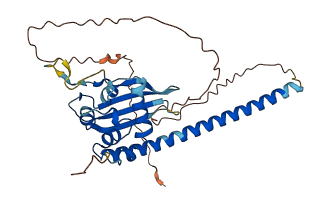Descriptions
The autoinhibited protein was predicted that may have potential autoinhibitory elements via cis-regPred.
Autoinhibitory domains (AIDs)
Target domain |
|
Relief mechanism |
|
Assay |
cis-regPred |
Accessory elements
No accessory elements
Autoinhibited structure

Activated structure

1 structures for O19110
| Entry ID | Method | Resolution | Chain | Position | Source |
|---|---|---|---|---|---|
| AF-O19110-F1 | Predicted | AlphaFoldDB |
2 variants for O19110
| Variant ID(s) | Position | Change | Description | Diseaes Association | Provenance |
|---|---|---|---|---|---|
| 306 | Y>L | No | |||
| 314 | V>M | No |
No associated diseases with O19110
No regional properties for O19110
| Type | Name | Position | InterPro Accession |
|---|---|---|---|
| No domain, repeats, and functional sites for O19110 | |||
3 GO annotations of cellular component
| Name | Definition |
|---|---|
| chromatin | The ordered and organized complex of DNA, protein, and sometimes RNA, that forms the chromosome. |
| cytoplasm | The contents of a cell excluding the plasma membrane and nucleus, but including other subcellular structures. |
| nucleus | A membrane-bounded organelle of eukaryotic cells in which chromosomes are housed and replicated. In most cells, the nucleus contains all of the cell's chromosomes except the organellar chromosomes, and is the site of RNA synthesis and processing. In some species, or in specialized cell types, RNA metabolism or DNA replication may be absent. |
2 GO annotations of molecular function
| Name | Definition |
|---|---|
| chromatin binding | Binding to chromatin, the network of fibers of DNA, protein, and sometimes RNA, that make up the chromosomes of the eukaryotic nucleus during interphase. |
| histone binding | Binding to a histone, any of a group of water-soluble proteins found in association with the DNA of eukaryotic or archaeal chromosomes. They are involved in the condensation and coiling of chromosomes during cell division and have also been implicated in gene regulation and DNA replication. They may be chemically modified (methylated, acetlyated and others) to regulate gene transcription. |
4 GO annotations of biological process
| Name | Definition |
|---|---|
| cell differentiation | The process in which relatively unspecialized cells, e.g. embryonic or regenerative cells, acquire specialized structural and/or functional features that characterize the cells, tissues, or organs of the mature organism or some other relatively stable phase of the organism's life history. Differentiation includes the processes involved in commitment of a cell to a specific fate and its subsequent development to the mature state. |
| gonadal mesoderm development | The process whose specific outcome is the progression of the gonadal mesoderm over time, from its formation to the mature structure. The gonadal mesoderm is the middle layer of the three primary germ layers of the embryo which will go on to form the gonads of the organism. |
| nucleosome assembly | The aggregation, arrangement and bonding together of a nucleosome, the beadlike structural units of eukaryotic chromatin composed of histones and DNA. |
| spermatogenesis | The developmental process by which male germ line stem cells self renew or give rise to successive cell types resulting in the development of a spermatozoa. |
13 homologous proteins in AiPD
| UniProt AC | Gene Name | Protein Name | Species | Evidence Code |
|---|---|---|---|---|
| Q01105 | SET | Protein SET | Homo sapiens (Human) | SS |
| Q9H2G4 | TSPYL2 | Testis-specific Y-encoded-like protein 2 | Homo sapiens (Human) | PR |
| Q8N831 | TSPYL6 | Testis-specific Y-encoded-like protein 6 | Homo sapiens (Human) | PR |
| P0DME0 | SETSIP | Protein SETSIP | Homo sapiens (Human) | SS |
| Q01534 | TSPY1 | Testis-specific Y-encoded protein 1 | Homo sapiens (Human) | PR |
| P0CV99 | TSPY4 | Testis-specific Y-encoded protein 4 | Homo sapiens (Human) | PR |
| P0CV98 | TSPY3 | Testis-specific Y-encoded protein 3 | Homo sapiens (Human) | PR |
| P0CW00 | TSPY8 | Testis-specific Y-encoded protein 8 | Homo sapiens (Human) | PR |
| P0CW01 | TSPY10 | Testis-specific Y-encoded protein 10 | Homo sapiens (Human) | PR |
| A6NKD2 | TSPY2 | Testis-specific Y-encoded protein 2 | Homo sapiens (Human) | PR |
| Q9EQU5 | Set | Protein SET | Mus musculus (Mouse) | EV |
| Q63945 | Set | Protein SET | Rattus norvegicus (Rat) | SS |
| Q9R1M3 | Tspy1 | Testis-specific Y-encoded protein 1 | Rattus norvegicus (Rat) | PR |
| 10 | 20 | 30 | 40 | 50 | 60 |
| MSRPFASAPA | RGHRQGQEER | ERRSEEGGSV | PGPRTFQVVS | PVVTPGQEAT | LFRVEAVEEG |
| 70 | 80 | 90 | 100 | 110 | 120 |
| EARHEGDVAG | IGREFQLLAE | DIVEEVEVVA | DEEQEQRPSQ | ELEEKTVEEQ | GQERPGGPCE |
| 130 | 140 | 150 | 160 | 170 | 180 |
| RQELDALQAL | AALQVELSSE | REQNRRAYVQ | FMRKNHQRRK | RHLARRSTII | QGIPGFWAKA |
| 190 | 200 | 210 | 220 | 230 | 240 |
| IMSHPQVSVL | ISDQDQDFLG | YMMDLKVQVR | SHPPSRCKLI | FSFRDNPYFL | NSVIIKEYYL |
| 250 | 260 | 270 | 280 | 290 | 300 |
| DITGYRARRS | TPVHWFWDFE | RGAPSRRRDT | RSLNFLNWLS | GHNGPESNRI | AEIISEDVWD |
| 310 | |||||
| DPLKYYLREE | GSSVRDN |
